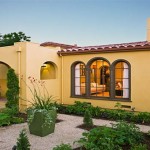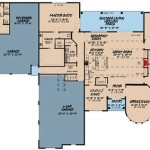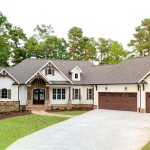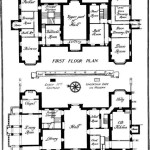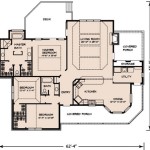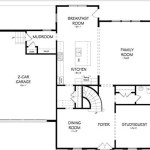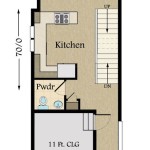6 Bedroom House Plans: The Convenience of One-Story Living
The appeal of single-story homes continues to resonate with a diverse range of homeowners. The accessibility they offer makes them particularly attractive to families with young children, individuals with mobility challenges, and those who simply prefer the convenience of having all living spaces on a single level. For larger families, or households requiring ample space for guests and home offices, a six-bedroom single-story house plan presents a compelling option, balancing the need for square footage with the ease of a horizontal layout.
Designing a six-bedroom home on one level poses unique challenges and opportunities. Careful consideration must be given to space allocation, traffic flow, privacy, and the overall aesthetic to ensure a comfortable and functional living environment. This article will delve into the key aspects of planning a six-bedroom single-story house, exploring various design considerations and highlighting the benefits of this type of layout.
Optimizing Space and Layout
The primary consideration in designing a six-bedroom single-story home is spatial efficiency. Achieving a balance between generously-sized bedrooms, comfortable living areas, and functional support spaces (such as bathrooms, kitchens, and storage) requires meticulous planning. Several design approaches can be employed to maximize space utilization.
Zoning: Dividing the house into distinct zones based on function is crucial. Common zoning strategies include separating the bedroom wing from the living areas, creating a master suite zone, and grouping service areas like laundry and mudrooms. This zoning approach helps to minimize noise transfer and maintain privacy between different areas of the house. For instance, placing the master suite at one end of the house, with living areas in the central portion and the remaining bedrooms grouped together on the opposite end, can provide a clear separation between the master's privacy and the children's area.
Open-Concept Living: Integrating the kitchen, dining area, and living room into an open-concept space can significantly enhance the feeling of spaciousness. This design maximizes natural light penetration and promotes social interaction within the family. However, proper acoustic treatment and strategic furniture placement are essential to prevent noise from becoming overwhelming in such a large, open area. The design needs also to consider visual separation where some definition can be created by the use of partial walls or changes in ceiling height.
Hallway Minimization: Long, meandering hallways can consume valuable square footage. Strategic placement of rooms and the use of shorter, more direct pathways can reduce wasted space. The incorporation of alcoves or strategically placed furniture in hallways can also transform them from mere passageways into functional areas, such as reading nooks or display spaces.
Flex Space: Incorporating flexible spaces that can serve multiple purposes is a smart way to maximize functionality. A bonus room above a garage (if the design incorporates a partially raised foundation) or a large room that can be divided into two smaller spaces with a temporary partition can provide additional versatility. These spaces can adapt to changing needs, serving as a home office, playroom, guest room, or home gym as required.
Orientation: The orientation of the house on the lot plays a vital role in maximizing natural light and ventilation. Ideally, the living areas should be oriented towards the south to capture sunlight during the day, while bedrooms can be positioned to the east for morning sun. Proper orientation can also help to reduce energy consumption for heating and cooling.
Outdoor Living Spaces: Extending the living space outdoors with patios, decks, or covered porches can significantly enhance the enjoyment of the home. These outdoor areas provide additional space for entertaining, relaxing, and enjoying the natural surroundings. They can also act as visual extensions of the indoor living areas, creating a sense of spaciousness.
Privacy and Functionality in Bedroom Design
Creating six bedrooms that are both comfortable and private requires careful consideration of their size, layout, and relationship to other rooms in the house. The design should prioritize privacy, sound insulation, and access to natural light and ventilation.
Bedroom Size: The size of each bedroom should be adequate to accommodate a bed, dresser, and possibly a desk or seating area. While the master bedroom typically receives the most generous allocation of space, the remaining bedrooms should still be of a comfortable size to ensure their functionality. The minimum recommended size for a bedroom is typically around 100 square feet, but larger rooms are generally preferred.
Bathroom Adjacency: Providing each bedroom with direct access to a bathroom is ideal, but may not always be feasible due to space constraints. A practical solution is to create multiple shared bathrooms strategically located within the bedroom wing. Consider designing a "Jack and Jill" bathroom shared by two adjacent bedrooms, or creating a larger bathroom accessible from a small hallway serving multiple bedrooms.
Master Suite Separation: The master suite should be designed as a private retreat separate from the other bedrooms. This can be achieved by locating it at the opposite end of the house or creating a buffer zone with a hallway or study area. The master suite typically includes a large bedroom, a walk-in closet, and a luxurious bathroom with amenities such as a soaking tub, separate shower, and dual vanities.
Sound Insulation: Sound insulation is especially important in a multi-bedroom house. Consider using sound-dampening materials in the walls, floors, and ceilings to minimize noise transfer between rooms. Solid-core doors and double-paned windows can also help to reduce noise levels. White noise machines may also be important in minimizing disruptions.
Closet Space: Ample closet space is essential in each bedroom. Walk-in closets are ideal, but reach-in closets with well-organized shelving and hanging rods can also be effective. Consider incorporating built-in storage solutions, such as drawers and shelves, to maximize closet space.
Natural Light and Ventilation: Each bedroom should have at least one window to provide natural light and ventilation. Windows should be strategically placed to maximize sunlight exposure and create a comfortable atmosphere. Consider using skylights or clerestory windows to bring in additional light, especially in rooms that may not have exterior walls.
Adapting the Design for Accessibility
One of the primary advantages of a single-story home is its inherent accessibility. However, careful planning is crucial to ensure that the design is truly accessible for individuals with mobility challenges. Universal design principles should be incorporated throughout the house to create a comfortable and usable environment for people of all ages and abilities.
Wide Doorways and Hallways: Doorways should be at least 36 inches wide to accommodate wheelchairs and walkers. Hallways should be at least 42 inches wide to allow for easy maneuvering. These dimensions ensure that individuals with mobility aids can navigate the house comfortably and safely.
Ramps and Level Entries: Eliminating steps and creating level entries is essential for accessibility. If steps are unavoidable, ramps should be installed with a gentle slope that meets ADA (Americans with Disabilities Act) guidelines. The slope should ideally be 1:12, meaning that for every inch of rise, there should be 12 inches of run.
Accessible Bathrooms: Bathrooms should be designed with accessibility in mind. Consider incorporating features such as grab bars near the toilet and shower, a roll-in shower with a seat, and a height-adjustable vanity. The toilet should be installed at a height of 17-19 inches, and the sink should have knee clearance underneath. Lever-style faucets are also easier to operate for individuals with limited dexterity.
Kitchen Accessibility: The kitchen should be designed with accessible countertops, appliances, and storage. Countertops should be installed at varying heights to accommodate individuals who are standing or seated. Appliances should be easy to reach and operate. Roll-under sinks and adjustable shelving can also enhance kitchen accessibility.
Easy-to-Grip Hardware: Use lever-style door handles and faucets throughout the house, as they are easier to grip and operate than traditional doorknobs. Consider installing rocker-style light switches, which are also easier to use.
Clear Pathways: Ensure that pathways throughout the house are clear and free of obstacles. Avoid using throw rugs or other tripping hazards. Adequate lighting is also essential for safe navigation, especially at night.
Designing a six-bedroom single-story home requires a comprehensive approach that balances spatial efficiency, privacy, functionality, and accessibility. By carefully considering these key aspects, it is possible to create a spacious, comfortable, and accessible living environment that meets the needs of a large or multi-generational family.

Large 6 Bedroom Bungalow 10000 Sf One Y Dream House Plans Designs Floor

6 Bedroom Barndominium Floor Plans The 9 Best Available

House Plan 107 1212 6 Bedroom 4945 Sq Ft Coastal Home Tpc Aa4945 9514

The Valdosta 3752 6 Bedrooms And 4 Baths House Designers Bedroom Plans One Story Ranch Style

Luxury Home Plan 6 Bedrms 7 5 Baths 8205 Sq Ft 117 1053

Ranch Style House Plan 6 Beds 4 Baths 4666 Sq Ft 472 94 Bedroom Plans One Story

6 Bedrooms And 5 Baths Plan 7023

6 Bedroom House Plans Houseplans Blog Com

783 M2 8428 Sq Foot 6 Bedroom House Plan Sherwood

Cottage House Plan With 6 Bedrooms And 4 5 Baths 4588

